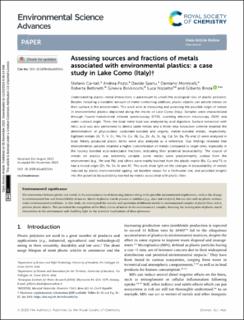| dc.description.abstract | Understanding plastic–metal interactions is paramount to unveil the ecological risks of plastic pollution. Besides including a (variable) amount of metal-containing additives, plastic objects can adsorb metals on their surface in the environment. This work aims at measuring and assessing the possible origin of metals in environmental plastics deposited along the shores of Lake Como (Italy). Samples were characterized through Fourier-transformed infrared spectroscopy (FTIR), scanning electron microscopy (SEM) and water contact angle. Then, the total metal load was analysed by acid digestion. Surface extraction with nitric acid was also performed to detect labile metals and a three-step extraction scheme enabled the determination of physisorbed, carbonate-bonded and organic matter-bonded metals, respectively. Eighteen metals (Al, Ti, V, Cr, Mn, Fe, Co, Ni, Cu, Zn, As, Sr, Ag, Cd, Sn, Ba, Pb and U) were analysed in total. Newly produced plastic items were also analysed as a reference. Our findings revealed that environmental samples retained a higher concentration of metals compared to virgin ones, especially in the loosely bonded acid-extractable fractions, indicating their potential bioavailability. The source of metals on plastics was extremely variable: some metals were predominantly sorbed from the environment (e.g., Mn and Pb), and others were mainly leached from the plastic matrix (Ba, Cu and Ti) or had a mixed origin (Zn, Fe, Sn, Sr and Al). This work shed light on the changes in bioavailability of metals induced by plastic environmental ageing, set baseline values for a freshwater site, and provided insights into the potential bioavailability exerted by metals associated with plastic litter. | en_US |

